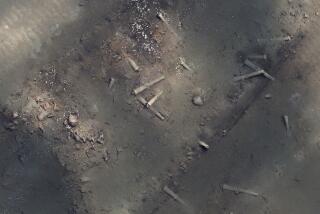Ship Archeologists Awash in Historic Dutch Wrecks
- Share via
TEXEL ISLAND, Netherlands — Corneilis Claesoon’s merchant vessel, bearing a cargo of grain from Poland to the Mediterranean, eased into the sound off this westerly island to seek shelter from the rising storm.
The year was 1592, or maybe 1593, and Claesoon, the gunner, was on board to operate a small 4-pounder cannon to protect the ship from pirates who prowled the English Channel and from the feared marauders of North Africa’s Barbary Coast.
A fierce wind howled through the narrow gap between Texel Island and the Dutch mainland. The Waddenzee, the marshy sea north of the Dutch mainland, was crowded with ships, their square-rigged sails tightly furled, waiting out the storm. But the gale proved too strong.
Vessels twisted and strained at their anchors as the wind shifted. The huge metal prongs couldn’t hold their grip in the soft, sandy seabed, and the windblown ships dragged them across the shallow water, snapping the anchor lines of others. Oak wood cracked as the ships broke free and crunched into each other. Sailors jumped in panic as their boats collided and sank.
The story is reasonable conjecture pieced together from the remains of the ship and the clutter of nearby wreckage.
They are just some of as many as 20,000 ships that lie at the bottom of the sea off the Dutch coast, according to estimates by the Netherlands Institute for Ship and Underwater Archeology.
Several thousand of those ships are more than 200 years old. Much of the wreckage, although broken and scattered, has been remarkably well preserved in the sand under the treacherous sea around the Netherlands, making the coast an untapped archeological trove.
“Nowhere will you find conditions like this,” said Arent Vos, head of the institute’s six-man archeological diving unit. Marine archeology, a relatively new science, is proving to be a powerful tool for historians. “You will find stuff that you will never find on land,” he said.
Vos’ team retrieved a 300-year-old bottle of wine, which experts found to be “surprisingly good” when it was opened in August.
In the 16th and 17th centuries, Holland built an empire and huge wealth on the backs of its trading fleet, which left Dutch names scattered from Spitsbergen in the Arctic to Tasmania in Australia and Staten Island and New Amsterdam, later to become New York City.
But little is known about the ships themselves or the shipwrights. The men who helped create the most powerful and richest mercantile nation then on earth were illiterate, leaving no records or drawings as they redesigned ships for speed and economy.
Unlike the British navy of mighty warships manned by hundreds of sailors, the Dutch merchant marine was largely a fleet of light, bulky vessels called fluiten, or flyboats.
For more than a century, some 3,000 ships left Dutch ports every year carrying half of Europe’s trade. Only a handful of larger vessels made long-distance voyages to the Spice Islands--now part of Indonesia--and elsewhere in Asia, Africa and the New World.
Because they were built cheaply to last only 15 years or so, few of the ships have survived.
Shipwrecks were so common they became a motif of 17th century art. Contemporaries of Rembrandt and Vermeer painted heroic pictures of ships struggling in stormy seas, and shipwreck epics were the stuff of pulp fiction.
For the modern historian, “each wreck is a story and a drama. A few good men died on these ships,” said Vos.
“Some went down in a moment. So it’s kind of like a time capsule,” he said, stripping off his wetsuit to relax on the bow of his research ship after completing one of his last dives of the season.
Vos has learned a lot, for example, about the gunner Claesoon and life on board his 105-foot ship, which he found after a tip from local fishermen when the seabed shifted to expose the wreckage after 400 years.
Although Vos is still searching for the ship’s name, he knows from the pattern of rings in the timber that it was built in 1582. The grain it carried was a type grown in Poland, and the light armament indicated its destination was the Mediterranean.
Vos believes the ship may have gone down with 43 others in a great storm that hammered the Waddenzee in 1592. If that’s true, then Claesoon appears to have survived, since his name appears on a list of gunnery men on another ship in 1593.
More to Read
Sign up for Essential California
The most important California stories and recommendations in your inbox every morning.
You may occasionally receive promotional content from the Los Angeles Times.













